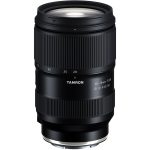Announced
Production status
Original name
Pros and cons
Genres or subjects of photography
Recommended slowest shutter speed when shooting static subjects handheld
Tamron 28-75mm F/2.8 Di III RXD A036
Standard zoom lens • Digital era • Discontinued
Abbreviations
| DI III | The lens is designed for digital mirrorless cameras. |
| RXD | The lens is equipped with Rapid eXtra-silent stepping Drive. |
Model history
| ■Tamron 28-75mm F/2.8 Di III RXD A036 | A | 15 - 12 | 0.19m | ⌀67 | 2018 ● | |
| ■Tamron 28-75mm F/2.8 Di III VXD G2 A063 | A | 17 - 15 | 0.18m | ⌀67 | 2021 ● | |
Specification



| Optical design: | |
| 28mm - 75mm [2.7X zoom ratio] | |
| F/2.8 across the focal length range | |
| 35mm full frame | |
| Sony E | |
| 75.4° @ 28mm - 32.2° @ 75mm (35mm full frame) | |
| 15 elements in 12 groups | |
| 3 ASPH, 1 XLD, 1 LD | |
| Internal focusing (IF) | |
| On Sony NEX/a/ZV APS-C [1.53x] cameras: | |
35mm equivalent focal length range: | 42.8mm - 114.8mm (in terms of field of view) |
35mm equivalent speed range: | F/4.3 (in terms of depth of field) |
Diagonal angle of view: | 53.6° @ 28mm - 21.3° @ 75mm |
| Diaphragm mechanism: | |
Diaphragm type: | Automatic |
Aperture control: | None; the aperture is controlled from the camera |
| 9 (nine) | |
| Zooming: | |
Zoom mechanism: | Manual |
Zoom control: | Zoom ring |
Zoom type: | Rotary |
Zooming method: | Extends while zooming |
| Focusing: | |
| 0.19m @ 28mm | |
| 0.39m @ 75mm | |
| 1:4 @ 75mm | |
Focusing modes: | Autofocus, manual focus |
Autofocus motor: | Rapid eXtra-silent stepping Drive |
Manual focus control: | Focusing ring |
Focus mode selector: | None; focusing mode is set from the camera |
Manual focus override in autofocus mode: | Determined by the camera |
| Vibration Compensation (VC): | |
| - | |
| Physical characteristics: | |
| 550g | |
| ⌀73×117.8mm | |
| Water-resistant barrel | |
| Yes | |
| Accessories: | |
| Screw-type 67mm | |
| HA036 - Bayonet-type petal-shaped | |
| Not available |
Source of data
- Manufacturer's technical data.
Manufacturer description
Packing cutting-edge technology into a compact body, Tamron has created a high-speed zoom lens specifically designed for mirrorless cameras: the 28–75mm F/2.8 Di III RXD (Model A036). A great addition to the Sony E-mount, the A036 strikes a beautiful balance between vibrant image quality, superb bokeh, compact size and lighter weight.
Specialized glass elements throughout control various aberrations and produce stable resolution across the entire zoom range. All the lens surface is treated with Tamron’s proprietary BBAR (Broad-Band Anti-Reflection) Coating, which dramatically reduces ghosting and flaring while preserving crisp image quality. The A036 also incorporates an all-new high-speed precision AF drive system with an RXD (Rapid eXtra-silent stepping Drive) motor unit that is remarkably quiet.
In addition to portraits, nature shots and street photography, the 0.19m Minimum Object Distance (MOD) lets you enjoy new forms of photographic expression with close-up shooting at the wide-angle end. With Moisture-Resistant Construction and Fluorine Coating, this lens offers exceptional mobility and outdoor functionality. It is the only zoom you need to portray the world in all its full-frame beauty.
The A036 zoom delivers a dazzling balance of clear yet soft rendering, stunning bokeh and exceptional resolution for in-focus areas. It also captures the finer details across the entire focus plane with performance that supports the latest high-resolution cameras—all while expressing the characteristic smoothness of a fast aperture lens. Stunning bokeh spreads gently from the plane of focus to highlight your subject. By stopping down the aperture, you can alter how images are rendered. The lens also incorporates a nine-bladed aperture that produces beautifully round defocused light points. And Tamron’s distinctive image characteristics, which produce more than just a different degree of blur with F-stop changes, add even more impact.
The A036 zoom is designed to maximize the potential of full-frame mirrorless cameras. Because it is designed to be your most frequently used high-speed zoom, we made it compact. Now you can enjoy advanced optical performance in a compact size with lightweight convenience. Weighing just 550g (19.4 oz) with a length of 117.8mm (4.6 in), the A036 lets you take advantage of the mobility offered by mirrorless cameras for everything from everyday snaps and commemorative photos to specialized photography.
The Model A036 breaks all the rules regarding MOD. No longer must the MOD of a zoom lens be fixed throughout the focal range. The A036 reaches a MOD of 0.19m (7.5 in) at the 28mm wide-angle end achieving a maximum magnification ratio of 1:2.9. A working distance of just 5.7cm (2.24 in) from the front element allows you to shoot close-up with a sense of perspective unique to wide angles. At the 75mm telephoto end, the 0.39m (15.3 in) MOD provides an image magnification of 1:4, allowing close-up shooting with a pleasantly blurred background similar to a macro lens.
The AF drive on the A036 includes an RXD (Rapid eXtra-silent stepping Drive) motor unit to help you stay focused on the action. RXD uses an actuator to precisely control the rotational angle of the motor, allowing it to directly drive the focusing lens without passing through a reduction gear. A sensor that accurately detects the position of the lens enables high-speed and precise AF, which is ideal when shooting continually moving subjects or video. With a focusing system that is both smooth and quiet, the A036 lets you shoot a video without worrying about picking up ambient drive sounds.
Tamron’s new 28-75mm zoom is compatible with many of the advanced features that are specific to mirrorless cameras. This includes:
- Fast Hybrid AF
- Eye AF
- Direct Manual Focus (DMF)
- In-camera lens correction (shading, chromatic aberration, distortion)
- Camera-based lens unit firmware updates
For greater protection when shooting outdoors, leak-resistant seals throughout the lens barrel help protect your equipment.
The front surface of the lens element is coated with a protective fluorine compound that is water- and oil-repellant. The lens surface is easier to wipe clean and is less vulnerable to the damaging effects of dirt, dust, moisture and fingerprints.
The application of BBAR (Broad-Band Anti-Reflection) Coating for suppressing reflections on lens element surfaces minimizes unwanted flare and ghosting to deliver sharp, crisp, high-contrast images.
The A036 zoom features our new “Human Touch” design, a mixture of form and function embodied by the “Luminous Gold” brand ring above the lens mount. It tells you that no detail has been overlooked in creating a design and feel that’s easy to work with—everything you look for in a photography partner. And everything you expect from Tamron.
Travellers' choice
- Fast speed (F/2.8)
- Lightweight (550g)
- Water-resistant barrel
- Fluorine coating
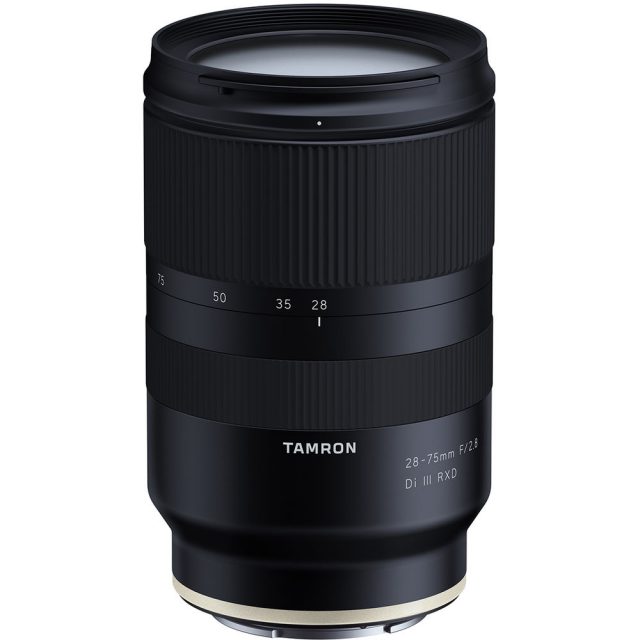

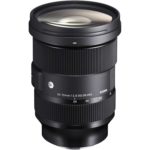
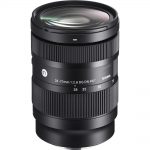
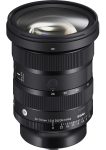
![Sony FE 28-70mm F/3.5-5.6 OSS [SEL2870]](https://lens-db.com/wp-content/uploads/2013/10/SEL2870-112x150.jpg)
![Sony FE Carl Zeiss Vario-Tessar T* 24-70mm F/4 ZA OSS [SEL2470Z]](https://lens-db.com/wp-content/uploads/2013/10/SEL2470Z-112x150.jpg)
![Sony FE 24-70mm F/2.8 GM [SEL2470GM]](https://lens-db.com/wp-content/uploads/2016/02/1454514369000_IMG_582668-150x150.jpg)
![Sony FE 24-70mm F/2.8 GM II [SEL2470GM2]](https://lens-db.com/wp-content/uploads/2022/04/1651055728_1702384-108x150.jpg)
